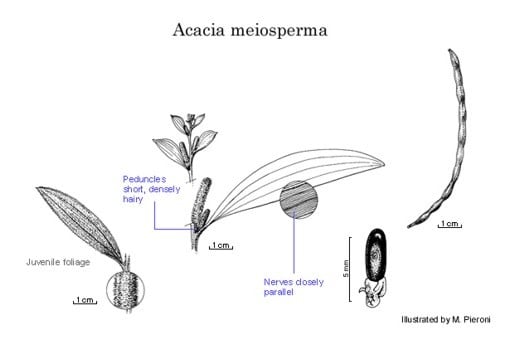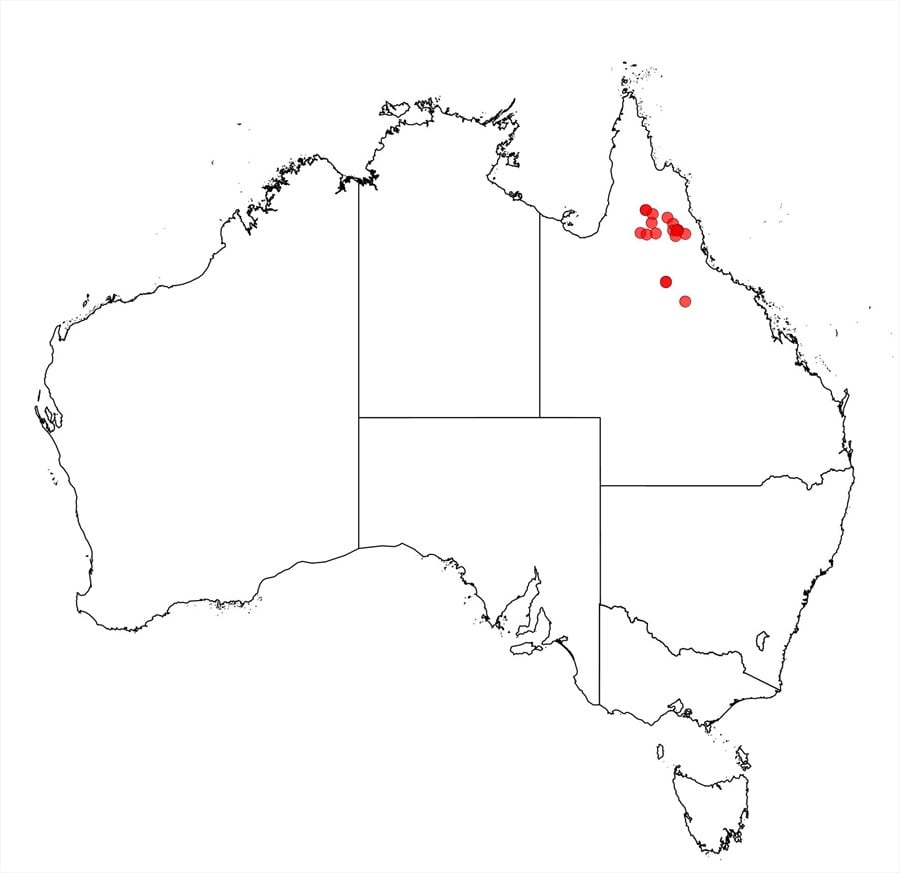Acacia meiosperma (Pedley) Pedley
WATTLE
Acacias of Australia
Family
Fabaceae
Distribution
Confined to a small area c. 40 km SE of Chillagoe, Qld.
Description
Shrub or tree 2–3 m high, pubescent when young. Branchlets angular and resinous at extremities, usually glabrous. Phyllodes inequilaterally narrowly elliptic, straight or shallowly falcately recurved, 6.5–12.5 cm long, (1.5–) 2–3 cm wide, usually glabrous, resinous when young; longitudinal nerves numerous (8–12 (–14) per mm), fine, close, parallel and not anastomosing, 3–5 more prominent than the rest; pulvinus 5–10 mm long. Inflorescences initiated synchronously with phyllodes on new shoots, 1–4 per axil, rarely in short racemes 0.5–10 mm long; peduncles 3–5 mm long, densely hairy; basal bract brown, caducous; spikes 1.5–3.5 cm long, golden. Flowers 5‑merous; sepals free to 1/4-united; ovary often absent, densely hairy. Pods linear-compressed, to 8 cm long, 3 mm wide, coriaceous, obscurely longitudinally ribbed, glabrous. Seeds longitudinal, oblong, 3–4 mm long, glossy, dark brown but yellow at centre; funicle-aril folded, creamy white.
Habitat
Forms pure stands in shallow stony soil.
Specimens
Qld: 23 km E of Almaden on the road to Chillagoe, J.R.Clarkson 2988 (BRI, K n.v, PERTH, QRS n.v..); near Almaden, L.Pedley 4841 (BRI).
Notes
Acacia meiosperma was referred to the ‘A. cheelii group’ by NSW, Fl. Austral. 11B: 265 (2001), but according to M.W.McDonald, Austral. Syst. Bot. 16: 140 (2003), it is a member of the ‘A. tumida group’. In the absence of pods, specimens with falcate phyllodes (e.g. Clarkson 2988, cited above) may resemble A. crassicarpa which is readily distinguished by its glabrous peduncles.
Young plants are pubescent and long hairs persist on branches and phyllodes of some mature plants.
FOA Reference
Data derived from Flora of Australia Volumes 11A (2001), 11B (2001) and 12 (1998), products of ABRS, ©Commonwealth of Australia
Author
Minor edits by B.R.Maslin & J.Rogers
B.R.Maslin, R.S.Cowan
This identification key and fact sheets are available as a mobile application:
URL: https://apps.lucidcentral.org/wattle/
© Copyright 2018. All rights reserved.







